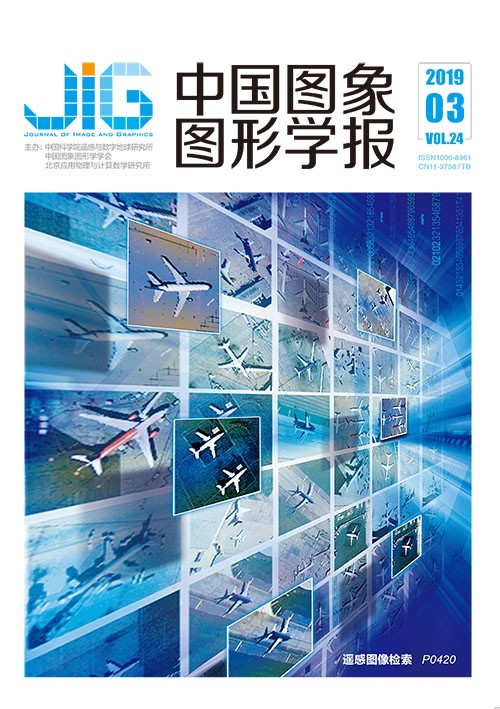
改进的曲率滤波强噪声图像去噪方法
摘 要
目的 医学影像获取和视频监控过程中会出现一些恶劣环境,导致图像有许多强噪声斑点,质量较差。在处理强噪声图像时,传统的基于变分模型的算法,因需要计算高阶偏微分方程,计算复杂且收敛较慢;而隐式使用图像曲率信息的曲率滤波模型,在处理强噪声图像时,又存在去噪不完全的缺陷。为了克服这些缺陷,在保持图像边缘和细节特征的同时去除图像的强噪声,实现快速去噪,提出了一种改进的曲率滤波算法。方法 本文算法在隐式计算曲率时,通过半窗三角切平面和最小三角切平面的组合,用投影算子代替传统曲率滤波的最小三角切平面投影算子,并根据强噪声图像存在强噪声斑点的特征,修正正则能量函数,增添局部方差的正则能量,使得正则项的约束更加合理,提高了算法的去噪性能,从而达到增强去噪能力和保护图像边缘与细节的目的。结果 针对多种不同强度的混合噪声图像对本文算法性能进行测试,并与传统的基于变分法的去噪算法(ROF)和曲率滤波去噪等算法进行去噪效果对比,同时使用峰值信噪比(PSNR)和结构相似性(SSIM)作为滤波算法性能的客观评价指标。本文算法在对强噪声图像去噪处理时,能够有效地保持图像的边缘和细节特征,具备较好的PSNR和SSIM,在PSNR上比ROF模型和曲率滤波算法分别平均提高1.67 dB和2.93 dB,SSIM分别平均提高0.29和0.26。由于采用了隐式计算图像曲率,算法的处理速度与曲率滤波算法相近。结论 根据强噪声图像噪声特征对曲率滤波算法进行优化,改进投影算子和能量函数正则项,使得曲率滤波算法能够更好地适用于强噪声图像,实验结果表明,该方法与传统的变分法相比,对强噪声图像去噪效果显著。
关键词
Strong noise image-denoising algorithm based on improved curvature filters
Tang Cheng1, Xu Jianlong1, Zhou Zhiguang2(1.School of Information Science and Technology, Zhejiang Sci-Tech University, Hangzhou 310018, China;2.School of Information, Zhejiang University of Finance and Economics, Hangzhou 310018, China) Abstract
Objective Harsh environments exist in the process of medical image acquisition and video surveillance. Such environments lead to poor image quality and many strong noise spots, which in turn affect the doctor's identification of lesions. When dealing with strong noise images, traditional variational model-based algorithms are computationally complex and have slow convergence because they need to calculate high-order partial differential equations. The curvature filtering model that implicitly uses image curvature information deals with strong noise images, and incomplete denoising defects occur. An improved curvature filtering algorithm is proposed in this study to overcome these deficiencies and achieve strong noise removal from images while maintaining the edge and detail features of the images and realizing a fast denoising process. Method This study proposes a novel algorithm for strong noise denoising based on improved curvature filters. The curvature is implicitly calculated, such that the proposed algorithm is as fast as the curvature filtering algorithm. The semi-window triangular tangent plane is combined with the minimum trigonometric tangent plane projection operator to replace the only minimum triangulation tangent plane projection operator for traditional curvature filtering, thereby enhancing the denoising capability of the algorithm aiming for strong noise images. According to the characteristics of strong noise spots in strong noise images, the regular energy function is modified, and the regular energy of local variance is added. These actions result in a reasonable constraint of regular terms and improves the denoising performance of the algorithm, thus enhancing the denoising capability and protecting the image edges. Result An improved curvature filtering algorithm is proposed to denoise strong noise images. Images are reconstructed based on the Gaussian curvature and local variance. Denoising performance is improved, particularly in processing images with high noise.The performance of the proposed algorithm is tested against mixed noise images of different intensities to verify its effect and texture-preserving capability. For instance, 0.1-density salt-and-pepper-mixed Gaussian noise with a standard deviation of 50 is added to the classic image of Lena and an emphysema CT lung image in the experiment. The noise reduction effects are compared with those of the traditional algorithms based on the denoising algorithm (Rudin-Osher-Fatemi model, ROF) and curvature filtering and denoising. Peak signal-to-noise ratio (PSNR) and structural similarity (SSIM) are used as objective evaluation indicators of the performance of the filtering algorithm. The proposed algorithm can effectively preserve the edge and detail features of images when denoising high-noise images and has good PSNR and SSIM. For the mixed salt-and-pepper noise density of 0.02 and Gaussian noise variance of 30 compared with the ROF model and the curvature filtering algorithm, the PSNR can be improved by 0.196 dB and 2.264 dB, respectively, and the SSIM can increase by 0.13 and 0.305, respectively. Especially in strong noise environments, such as mixed salt-and-pepper noise density of 0.1, Gaussian noise variance of 50, and superimposed Poisson noise, experimental results show that the PSNR obtained by the proposed algorithm increases by 2.196 dB more than the denoising image of the ROF model and by 3.194 dB more than the curvature filtering algorithm. The SSIM obtained by the proposed algorithm is 0.398 more than that of the ROF model and 0.403 more than that of the curvature filtering model. The traditional ROF model can achieve a good denoising image, but it requires 26 s of running time and thereby cannot achieve real-time denoising. Although curvature filtering can acquire denoising images in a relatively short time, its denoising capability is insufficient and noise cannot be removed efficiently. Implicitly calculated image curvature is adopted, and the processing speed of the algorithm is similar to that of the curvature filtering algorithm. Conclusion The curvature filtering algorithm is optimized based on the noise characteristics of strong noise images. According to the enhanced denoising capability projection operator and the modified energy function regularization term, the curvature filtering model can be better applied to strong noise images than traditional methods. Experiments are performed on images with three mixed strong noise levels. The corresponding running time, PSNR, and SSIM are calculated for comparison. The PSNR, SSIM, and image visual effect of the proposed method are superior to those of the total variation(TV) and adaptive fidelity term total variation (AFTV) models, particularly for the images polluted by strong noise. The running time of the proposed algorithm is close to that of the curvature filtering algorithm and is significantly faster than that of the ROF model. Experimental results show that compared with the traditional variational method, the proposed algorithm has a significant effect on denoising strong noise images.
Keywords
|



 中国图象图形学报 │ 京ICP备05080539号-4 │ 本系统由
中国图象图形学报 │ 京ICP备05080539号-4 │ 本系统由